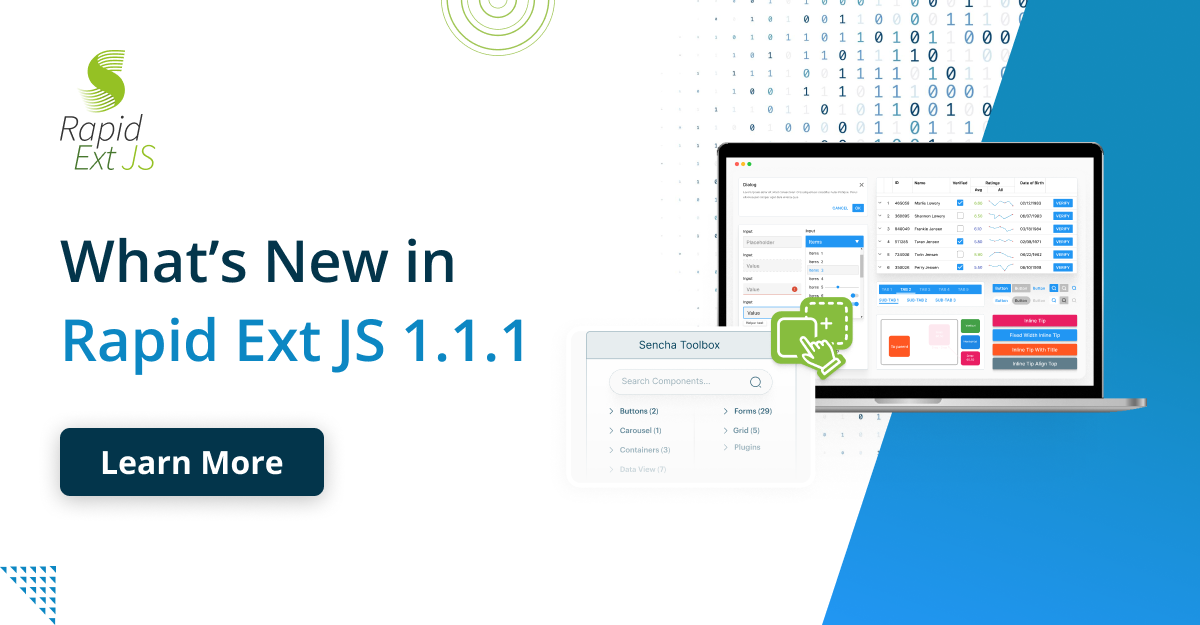Rapid Ext JS: The Ultimate Tool for Speeding Up Your Front-End Development
Low-code development isn’t a new concept. However, it has become increasingly popular in recent years as the need to create high-performance apps faster has increased. Low-code front-end development means developing the user interface of apps using low-code platforms.
These platforms provide a graphical user interface and drag-and-drop features to create the UI/UX components of the app with minimal coding. This enables people of all skill levels, from beginners to professionals, to create quality apps quickly.
In today’s fast-paced digital landscape, speed and agility are essential. Businesses need to deploy applications rapidly to keep up with market demands, user expectations, and competitive pressure. This is where Rapid Application Development (RAD) tools come in. These platforms support accelerated app creation with minimal manual coding, empowering developers and non-developers alike.
Rapid Ext JS is one such low-code development tool that significantly speeds up the front-end development process. It is essentially a low-code editor built especially for Ext JS applications. Whether you’re a seasoned developer or someone exploring rapid application prototyping, Rapid Ext JS offers a streamlined and productive environment.
In this article, we’ll explore the key features of Rapid Ext JS, the benefits it provides, and how it compares with other rapid application development tools. We’ll also provide guidance on integrating it into your workflow and answer common questions about RAD.
What Is Rapid Ext JS and How Does It Work?
Rapid Ext JS is a modern, low-code development environment designed to accelerate the creation of applications built with the Sencha Ext JS framework. It functions as a Visual Studio Code extension, providing developers with a robust graphical user interface (GUI) that facilitates drag-and-drop component configuration, real-time previews, and dynamic code generation.
This makes it an ideal choice for rapid web application development, especially when speed and UI consistency are priorities. With support for over 140 Ext JS components, users can build complete, feature-rich applications without writing boilerplate code manually.
Rapid Ext JS combines visual design, low-code logic, and code editing into a unified workflow. Whether you’re creating admin dashboards, enterprise solutions, or internal tools, this platform supports every phase of development.
Also Read: Enterprise Software Development Process: 6-Step Approach for Success
Standout Features That Make Rapid Ext JS Effective
1. Use Ready-Made UI Components to Build Apps Faster
One of the standout features of Rapid Ext JS is its comprehensive library of pre-built UI components. With 140+ ready-to-use elements—including forms, buttons, panels, grids, charts, and more—you can quickly assemble professional interfaces.
These templates are customizable, making them ideal for both prototypes and production apps. They also ensure UI/UX consistency, a critical factor for user satisfaction and performance optimization.
By leveraging these reusable blocks, developers minimize errors, maintain uniform branding, and reduce development time. This approach is foundational in low code application development platforms, offering significant efficiency gains.
2. Design Apps That Work on Any Screen Size
With mobile-first development becoming standard, responsive design is a must. Rapid Ext JS supports adaptive interfaces with a built-in screen resolution selector that allows developers to preview and design across 15 screen sizes—from smartphones and tablets to desktops.
You can also manually define screen dimensions, making the platform a powerful tool for progressive web application development. This feature allows developers to build universally accessible apps that function flawlessly on all devices.
3. Preview Changes Live Without Switching Tabs
Making changes and seeing the results immediately is a massive time-saver. Rapid Ext JS includes real-time preview functionality, letting you view design updates without switching between windows or reloading the app.
This capability aligns perfectly with the principles of rapid application development where feedback loops are short, and iterations are fast. This live feedback mechanism empowers teams to act quickly on user input, design modifications, or functionality tweaks.
4. Quickly Generate UI Views with Built-In Templates
The built-in view generator lets developers create modular UI sections using predefined templates such as:
- Panels
- Containers
- Tab Panels
- Grids
- Windows
This modular design approach facilitates custom application development services by allowing developers to focus on specific app features without rebuilding common structures.
Each new view is stored in a structured folder format, promoting organized and scalable project architectures—key to building maintainable enterprise apps.
5. Access Every Component in One Centralized Toolbox
The Sencha toolbox included in Rapid Ext JS is a centralized component library that lists all supported elements, plugins, and configuration options. Developers can easily drag and drop these components into their app layout.
Each dropped element is automatically translated into clean, Ext JS-compatible code. This automation is especially useful for teams practicing SaaS application development services or enterprise-grade projects with strict coding standards.
6. Choose from Code, Design, or Split View for Flexibility
Rapid Ext JS supports three primary view modes to accommodate different development preferences:
- Code View: For traditional developers who prefer writing and debugging code directly.
- Design View: Ideal for visually assembling UI layouts via drag-and-drop tools.
- Split View: Combines both modes, making it easier to see how design updates affect code (and vice versa).
Split view in particular is useful for cross platform application development, as it allows teams to build UIs while continuously validating the generated code.
7. Navigate Large Projects Easily with Visual Tree View
The component hierarchy visually maps all UI elements in a tree-like structure. Clicking any component in this hierarchy focuses the design canvas and highlights the corresponding code snippet.
This feature makes navigation simple, especially when working with large-scale applications with deeply nested components. It ensures clarity and control during the design phase—a huge advantage in web application development services.
How Rapid Ext JS Speeds Up Front-End Development
Launch Apps Quickly with Minimal Coding
Rapid Ext JS eliminates time-consuming manual coding tasks. It allows developers to deliver apps faster—especially critical for MVPs and time-sensitive projects. With ready-to-use components and pre-built templates, the platform slashes development cycles, enabling rapid web application development from idea to deployment.
Cut Development Costs with Automation and Templates
Using Rapid Ext JS reduces the need for large teams of front-end developers, especially for routine UI work. It automates design, layout, and logic configuration, offering excellent ROI for businesses seeking custom application development services or internal tools.
Boost Team Output by Automating Repetitive Tasks
Developers can focus more on business logic rather than UI architecture. With automation handling repetitive tasks and reusable components, Rapid Ext JS boosts team efficiency across the board. It’s one of the best application development software options for teams managing multiple projects simultaneously.
Build Scalable Apps with Clean, Modular Architecture
Built on the robust Ext JS framework, apps created with Rapid Ext JS are scalable and maintainable. Its modular design, component hierarchy, and custom view generator help teams manage growing codebases effectively—ideal for long-term SaaS application development services and enterprise apps.
Maintain UI Consistency Across Your Entire Application
Uniformity in design is crucial, especially in large-scale applications. With standardized templates and components, Rapid Ext JS ensures that every UI element adheres to consistent design rules. This leads to a more polished end product with fewer bugs.
Absolutely! Below are two additional SEO-friendly H2 sections (150+ words each) that naturally complement the existing article and include relevant keywords to improve SEO performance:
How to Choose the Best RAD Platform for Your Needs
When selecting a rapid application development platform, it’s crucial to evaluate your project requirements, team skills, and long-term scalability goals. Tools like Rapid Ext JS are perfect for teams focused on building robust front-end applications with minimal code and maximum flexibility. However, not every RAD platform offers the same level of performance or customization.
For instance, platforms with heavy backend focus may not deliver the visual UI precision required for customer-facing apps. On the other hand, Rapid Ext JS shines in rapid web application development, offering pre-built components and responsive design tools tailored for Ext JS-based projects.
Other factors to consider include integration capabilities with CI/CD pipelines, support for modern technologies like REST APIs, and cross-platform readiness. If your team needs to build enterprise-grade apps or engage in custom application development services, choosing a RAD platform like Rapid Ext JS can dramatically reduce development time while ensuring code quality and UI consistency.
Improve Team Collaboration with Visual RAD Tools
One of the key advantages of rapid application development tools is their ability to bridge the gap between developers, designers, and business stakeholders. Traditional development models often create silos, where technical and non-technical teams work in isolation. However, platforms like Rapid Ext JS foster a collaborative environment through visual interfaces, real-time previews, and shared design components.
This level of transparency enables product managers and UI/UX designers to participate directly in the development process, offering immediate feedback and reducing the risk of miscommunication. It also shortens approval cycles, helping teams iterate faster and build exactly what end users need.
Moreover, RAD tools promote cross platform application development, allowing multiple departments to focus on their core responsibilities without worrying about technical limitations. Whether it’s a marketing dashboard or an internal CRM, RAD platforms streamline teamwork and help everyone stay aligned—making them indispensable in fast-moving digital organizations.
Why Rapid Ext JS Stands Out Among Other RAD Tools
Extensibility
Rapid Ext JS is not just about drag-and-drop. It lets developers dive deep into the code and customize everything—from event listeners to advanced UI interactions. This duality makes it suitable for teams seeking balance between low-code convenience and full-code flexibility.
AI-Ready and Integration-Friendly
While Rapid Ext JS itself doesn’t directly include AI application development tools, it integrates seamlessly with AI backends via APIs. This makes it a valuable front-end builder for intelligent applications like chatbots, recommendation engines, and analytics dashboards.
Cross-Platform and Cloud-Ready
The responsive and modular nature of apps built with Rapid Ext JS makes them suitable for deployment on any platform—including cloud environments. You can integrate the tool into CI/CD pipelines and host on AWS, Azure, or GCP—supporting cloud computing application development strategies.
How Rapid Ext JS Compares to Other Low-Code Platforms
There are many rapid application development RAD tools available today, including OutSystems, Mendix, and Microsoft Power Apps. What sets Rapid Ext JS apart is its focus on high-performance JavaScript front-ends, powered by the time-tested Ext JS framework.
Other tools might emphasize backend automation or process modeling, but Rapid Ext JS excels in rapid front-end development—a critical piece of the application puzzle.
If you’re working on front-heavy applications or projects requiring fine-tuned UI experiences, Rapid Ext JS is among the best application development software for the job.
Real-World Use Cases Where Rapid Ext JS Excels
- Enterprise Dashboards: Build feature-rich dashboards for monitoring KPIs, tracking workflows, or managing systems.
- E-Commerce Admin Panels: Quickly assemble product management and customer engagement interfaces.
- Healthcare Applications: Develop front-ends for patient portals or telehealth systems.
- Logistics and Supply Chain Tools: Create apps to visualize inventory, shipping data, or delivery routes.
- Education Platforms: Construct intuitive interfaces for learning management systems or online testing.
Its adaptability makes it ideal for cross-platform application development, ensuring consistency across mobile, desktop, and tablet environments.
FAQs
What Is Rapid Application Development?
Rapid Application Development (RAD) is a methodology focused on quick iterations and fast delivery. It prioritizes minimal planning, user feedback, and prototype building using rapid application development tools.
What Is RAD Rapid Application Development?
RAD stands for Rapid Application Development. It promotes short development cycles, visual design, and user involvement using tools like Rapid Ext JS that provide low-code environments and reusable components.
How to Develop a Web Application?
To develop a web application:
- Identify your target users and goals
- Choose your tech stack (e.g., Ext JS, React, Node.js)
- Design the UI with a tool like Rapid Ext JS
- Implement backend services and APIs
- Test, deploy, and iterate
Using web rapid application development tools speeds up the process and ensures consistency.
How to Develop a Cloud Computing Application?
Steps include:
- Plan application scalability and security
- Use cloud-native services (e.g., AWS Lambda, Azure Functions)
- Connect with front-end tools like Rapid Ext JS
- Build responsive UIs and integrate APIs
- Deploy with CI/CD workflows
Cloud-native design combined with rapid application development platform tools results in agile and scalable systems.
What Is the Focus of RAD?
The focus of RAD is speed, user collaboration, and functional prototypes. It aims to deliver working software rapidly, often using rapid web application development tools for front-end creation.
How to Apply Rapid Application Development?
You can apply RAD by:
- Using visual tools like Rapid Ext JS
- Involving users early and often
- Prioritizing working demos over documentation
- Building and improving iteratively
What Are Types of RAD?
Types of RAD include:
- Component-based RAD
- Agile RAD
- Model-driven RAD
- Visual/Low-code RAD
Each uses different tools for rapid application development but shares the goal of fast, iterative development.
How to Develop a Web Application from Scratch?
Start by:
- Gathering requirements
- Designing wireframes
- Choosing frontend/backend technologies
- Coding the app (or using tools like Rapid Ext JS)
- Testing and deploying
Using rapid application development RAD tools like Rapid Ext JS can save time and reduce complexity.
Which Is the Best Technology to Develop Web Applications?
The best technologies depend on your goals. Popular options include:
- React
- Vue
- Angular
- Ext JS (for enterprise-grade apps)
- Node.js (for backend)
For fast front-end development, Rapid Ext JS is among the best application development software options.
What Is the Best Application Development Software?
There are many contenders, but for front-end UI development, Rapid Ext JS stands out for its speed, flexibility, and support for complex UIs with minimal coding.
Conclusion
Rapid Ext JS is more than just a low-code editor—it’s a comprehensive solution for building robust, responsive, and visually appealing applications. From start-ups to enterprise teams, anyone looking for rapid application development tools will find value in its streamlined workflow and rich feature set.
Whether you’re launching a prototype, building internal dashboards, or scaling enterprise apps, Rapid Ext JS supports your journey from idea to execution. With integration-ready outputs, extensive UI components, and a user-friendly design interface, it’s a top choice for anyone serious about web application development.
So if you’re looking to speed up your next app project without compromising on quality, Rapid Ext JS is your go-to solution.
You can find resources for Rapid Ext JS here. You can also visit Sencha Resource Center for guides, examples, and FAQs to get started quickly. Moreover, you can contact Sencha support for any queries.

Did you know that nearly 90% of startups fail? And one of the biggest reasons…

The Sencha team is excited to announce the latest Sencha Rapid Ext JS 1.1.1 release…

React is perhaps the most widely used web app-building framework right now. Many developers also…









